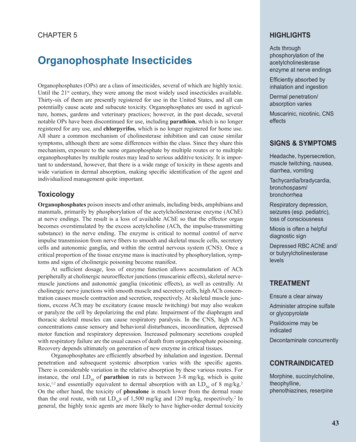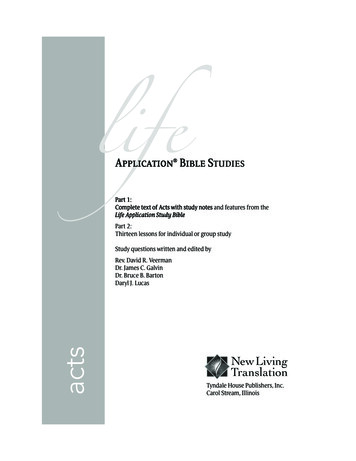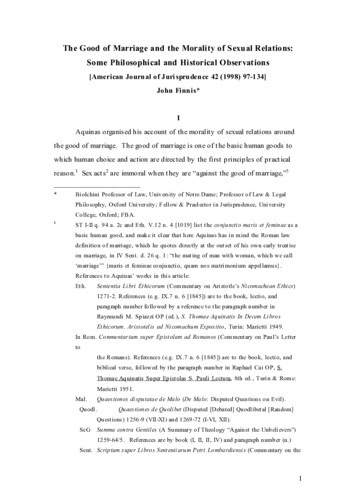
Transcription
CHAPTER 5HIGHLIGHTSOrganophosphate InsecticidesActs throughphosphorylation of theacetylcholinesteraseenzyme at nerve endingsOrganophosphates (OPs) are a class of insecticides, several of which are highly toxic.Until the 21st century, they were among the most widely used insecticides available.Thirty-six of them are presently registered for use in the United States, and all canpotentially cause acute and subacute toxicity. Organophosphates are used in agriculture, homes, gardens and veterinary practices; however, in the past decade, severalnotable OPs have been discontinued for use, including parathion, which is no longerregistered for any use, and chlorpyrifos, which is no longer registered for home use.All share a common mechanism of cholinesterase inhibition and can cause similarsymptoms, although there are some differences within the class. Since they share thismechanism, exposure to the same organophosphate by multiple routes or to multipleorganophosphates by multiple routes may lead to serious additive toxicity. It is important to understand, however, that there is a wide range of toxicity in these agents andwide variation in dermal absorption, making specific identification of the agent andindividualized management quite important.ToxicologyOrganophosphates poison insects and other animals, including birds, amphibians andmammals, primarily by phosphorylation of the acetylcholinesterase enzyme (AChE)at nerve endings. The result is a loss of available AChE so that the effector organbecomes overstimulated by the excess acetylcholine (ACh, the impulse-transmittingsubstance) in the nerve ending. The enzyme is critical to normal control of nerveimpulse transmission from nerve fibers to smooth and skeletal muscle cells, secretorycells and autonomic ganglia, and within the central nervous system (CNS). Once acritical proportion of the tissue enzyme mass is inactivated by phosphorylation, symptoms and signs of cholinergic poisoning become manifest.At sufficient dosage, loss of enzyme function allows accumulation of AChperipherally at cholinergic neuroeffector junctions (muscarinic effects), skeletal nervemuscle junctions and autonomic ganglia (nicotinic effects), as well as centrally. Atcholinergic nerve junctions with smooth muscle and secretory cells, high ACh concentration causes muscle contraction and secretion, respectively. At skeletal muscle junctions, excess ACh may be excitatory (cause muscle twitching) but may also weakenor paralyze the cell by depolarizing the end plate. Impairment of the diaphragm andthoracic skeletal muscles can cause respiratory paralysis. In the CNS, high AChconcentrations cause sensory and behavioral disturbances, incoordination, depressedmotor function and respiratory depression. Increased pulmonary secretions coupledwith respiratory failure are the usual causes of death from organophosphate poisoning.Recovery depends ultimately on generation of new enzyme in critical tissues.Organophosphates are efficiently absorbed by inhalation and ingestion. Dermalpenetration and subsequent systemic absorption varies with the specific agents.There is considerable variation in the relative absorption by these various routes. Forinstance, the oral LD50 of parathion in rats is between 3-8 mg/kg, which is quitetoxic,1,2 and essentially equivalent to dermal absorption with an LD50 of 8 mg/kg.2On the other hand, the toxicity of phosalone is much lower from the dermal routethan the oral route, with rat LD50s of 1,500 mg/kg and 120 mg/kg, respectively.2 Ingeneral, the highly toxic agents are more likely to have higher-order dermal toxicityEfficiently absorbed byinhalation and ingestionDermal penetration/absorption variesMuscarinic, nicotinic, CNSeffectsSIGNS & SYMPTOMSHeadache, hypersecretion,muscle twitching, nausea,diarrhea, horrheaRespiratory depression,seizures (esp. pediatric),loss of consciousnessMiosis is often a helpfuldiagnostic signDepressed RBC AChE and/or butyrylcholinesteraselevelsTREATMENTEnsure a clear airwayAdminister atropine sulfateor glycopyrolatePralidoxime may beindicatedDecontaminate concurrentlyCONTRAINDICATEDMorphine, succinylcholine,theophylline,phenothiazines, reserpine43
CHAPTER 5OrganophosphatesCOMMERCIALPRODUCTSHighly Toxic1azinphos-methyl (Guthion,Gusathion)bomyl2 (Swat)carbophenothion (Trithion)chlorfenvinphos (Apachlor,Birlane)chlormephos2 (Dotan)chlorthiophos2 (Celathion)coumaphos (Co-Ral, Asuntol)cyanofenphos2 (Surecide)demeton3 (Syntox)dialifor (Torak)dicrotophos (Bidrin)dimefos2 (Hanane, PestoxXIV)dioxathion (Delnav)disulfoton3 (Disyston)endothion2EPNethyl parathion (E605,Parathion, thiophos)famphur2 (Famfos, Bo-Ana,Bash)fenamiphos (Nemacur)fenophosphon2 (trichloronate,Agritox)continued next pageCompounds are listedapproximately in order ofdescending toxicity. “Highly toxic”organophosphates have listed oralLD50 values (rat) less than 50 mg/kg; “moderately toxic” agents haveLD50 values in excess of 50 mg/kgand less than 500 mg/kg.1Products no longer registered inthe United States.2These organophosphates aresystemic: they are taken up by theplant and translocated into foliageand sometimes into the fruit.344than the moderately toxic agents. To a degree, the occurrence of poisoning depends onthe rate at which the pesticide is absorbed. Breakdown occurs chiefly by hydrolysisin the liver, and rates of hydrolysis vary widely from one compound to another. Inthose organophosphates for which breakdown is relatively slow, significant temporarystorage in body fat may occur. Some organophosphates, such as diazinon, fenthionand methyl parathion, have significant lipid solubility, allowing fat storage withdelayed toxicity due to late release.3,4 Delayed toxicity may also occur atypically withother organophosphates, specifically dichlorofenthion and demton-methyl.5 Manyorganothiophosphates readily undergo conversion from thions (P S) to oxons (P O).Conversion occurs in the environment under the influence of oxygen and light and, inthe body, chiefly by the action of liver microsomal enzymes. Oxons are much moretoxic than thions, but oxons break down more readily than thions. Ultimately, boththions and oxons are hydrolyzed at the ester linkage, yielding alkyl phosphates andleaving groups, both of which are of relatively low toxicity. They are either excretedor further transformed in the body before excretion.After the initial exposure of the effector junction and the organophosphate, theenzyme-phosphoryl bond is strengthened by loss of one alkyl group from the phosphoryl adduct. This process is known as aging. The bond is then essentially permanent. Time of aging varies by agent and can occur within minutes to days. Dependingon the time of aging of the agent, some phosphorylated acetylcholinesterase enzymecan be de-phosphorylated (reactivated) by a compound known as an oxime. The onlycurrently FDA-approved oxime in the United States is pralidoxime. Other oximesinclude obidoxime and HI-6, which have been used in Europe and Asia. Depending onthe agent, pralidoxime reactivation may be no longer possible after a couple of days,6although in some cases, improvement has still been seen with pralidoxime administration days after exposure.7 Oximes have been used for OP poisoning for more than 50years.8 However, controversy remains as to the effectiveness of oximes because ofconflicting and limited evidence of efficacy.4,9,10Rarely, certain organophosphates have caused a different kind of neurotoxicityconsisting of damage to the afferent fibers of peripheral and central nerves and associated with inhibition of “neuropathy target esterase” (NTE). Certain organophosphatesare exceptionally prone to storage in fat tissue, prolonging the need for antidote forseveral days as stored pesticide is released back into the circulation.3,4,11 This delayedsyndrome has been termed organophosphate-induced delayed neuropathy (OPIDN)and is manifested chiefly by weakness or paralysis and paresthesia of the extremities.12OPIDN predominantly affects the legs and may persist for weeks to years. Only afew of the many organophosphates used as pesticides have been implicated as causesof delayed neuropathy in humans. EPA guidelines require that organophosphate andcarbamate compounds that are candidate pesticides be tested in susceptible animalspecies for this neurotoxic property.In addition to acute poisoning episodes and OPIDN, an intermediate syndromehas been described. This syndrome occurs after resolution of the acute cholinergiccrisis, generally 24–96 hours after exposure. It is characterized by acute respiratory paresis and muscular weakness, primarily in the facial, neck and proximal limbmuscles. In addition, it is often accompanied by cranial nerve palsies and depressedtendon reflexes. Like OPIDN, this syndrome lacks muscarinic symptoms and appearsto result from a combined pre- and post-synaptic dysfunction of neuromuscular transmission. Symptoms do not respond well to atropine and oximes; therefore, treatmentis mainly supportive.13,14 The most common compounds involved in this syndrome aremethyl parathion, fenthion and dimethoate, although one case with ethyl-parathionwas also observed.4,13
CHAPTER 5OrganophosphatesOther specific properties of individual organophosphates may render them morehazardous than basic toxicity data suggest. Certain organophosphates are exceptionally prone to storage in fat tissue, prolonging the need for antidote for several days asstored pesticide is released back into the circulation. In vitro and animal studies havedemonstrated potentiation or additive effects when two or more organophosphates areabsorbed simultaneously, thereby creating a cumulative effect.15,16 Animal studies havealso demonstrated additive effects when orgranophosphates are combined with otherpesticides including herbicides, carbamates and pyrethroids.17,18,19 Animal studies havedemonstrated a protective effect of toxicity from phenobarbital, which induces hepaticdegradation of the pesticide.1 Degradation of some compounds to a trimethyl phosphate can cause restrictive lung disease.20In the late 1950s and 1960s, several reports appeared suggesting that long-termeffects have occurred following acute and often massive exposures. Symptoms thatare consistently reported from exposed persons include depression, memory andconcentration problems, irritability, persistent headaches and motor weakness.21,22,23In these rare, anecdotal cases, symptoms have persisted for months to years. Thesehypothesis-generating cases eventually led to larger epidemiological studies with anexposed group and a control group that also supported the hypothesis that a proportion of patients acutely poisoned from any organophosphate can experience somelong-term neuropsychiatric sequelae. The findings included significantly impairedperformance on a battery of neuro-behavioral tests and compound-specific peripheralneuropathy, in some cases. Specific functions included impaired memory and concentration, depressed mood and peripheral neuropathy. These findings were subtle and, insome cases, picked up only on neuropsychologic testing rather than during neurologicexam.24,25,26 For information on chronic and long-term effects from OPs, includingsubacute effects and long-term exposure without acute poisoning, see Chapter 21,Chronic Effects.Highly ToxicCommercial Productscontinuedfensulfothion (Dasanit)fonofos (Dyfonate, N-2790)fosthietan (Nem-A-Tak)isofenphos (Amaze, Oftanol)mephosfolan2,3 (Cytrolane)methamidophos (Monitor)methidathion (Supracide,Ultracide)methyl parathion (E601,Penncap-M)mevinphos (Phosdrin,Duraphos)mipafox2 (Isopestox, PestoxXV)monocrotophos (Azodrin)phorate (Thimet, Rampart,AASTAR)phosfolan2,3 (Cyolane,Cylan)Signs and Symptoms of Poisoningphosphamidon (Dimecron)Symptoms of acute organophosphate poisoning develop during or after exposure,within minutes to hours, depending on method of exposure. Exposure by inhalationresults in the fastest appearance of toxic symptoms, followed by the oral route andfinally the dermal route. All signs and symptoms are cholinergic in nature and affectmuscarinic, nicotinic and central nervous system receptors.6 The critical symptomsin initial management are the respiratory symptoms. Sufficient muscular fasciculations and weakness are often observed and require respiratory support, as respiratory arrest can occur suddenly. Bronchospasm and bronchorrhea can occur, producingchest tightness, wheezing, productive cough and pulmonary edema. These can impedeefforts at adequate oxygenation of the patient. A life-threatening severity of poisoningis signified by loss of consciousness, incontinence, seizures and respiratory depression. The primary cause of death is respiratory failure.There usually is a secondary cardiovascular component to the respiratory symptoms. The classic cardiovascular sign is bradycardia, which can progress to sinusarrest. However, this may be superseded by tachycardia and hypertension from nicotinic (sympathetic ganglia) stimulation.27 Toxic cardiomyopathy has been reportedafter severe poisoning due to sarin, a weaponized organophosphate compound structurally similar to the insecticides.28Some of the most commonly reported early symptoms include headache, nausea,dizziness and hypersecretion, the latter of which is manifested by sweating, salivation, lacrimation and rhinorrhea. Muscle twitching, weakness, tremor, incoordination,vomiting, abdominal cramps and diarrhea all signal worsening of the poisoned state.prothoate2,3 (Fac)schradan2 (OMPA)sulfotep (Thiotepp,Bladafum, Dithione)terbufos (Counter,Contraven)tetraethyl pyrophosphate2(TEPP)Moderately Toxic1acephate (Orthene)bensulide (Betasan, Prefar)bromophos-ethyl2 (Nexagan)bromophos2 (Nexion)chlorphoxim2 (Baythion-C)chlorpyrifos (Dursban,Lorsban, Brodan)continued next page45
CHAPTER 5OrganophosphatesModerately ToxicCommercial Productscontinuedcrotoxyphos (Ciodrin, Cypona)crufomate2 (Ruelene)cyanophos2 (Cyanox)cythioate2 (Proban, Cyflee)DEF (De-Green, E-Z-Off D)demeton-S-methyl3 (Duratox,Metasystox-R)diazinon (Spectracide)dichlofenthion (VC-13Nemacide)dichlorvos (DDVP, Vapona)edifenphosethion (Ethanox)ethoprop (Mocap)etrimfos2 (Ekamet)fenitrothion (Accothion,Agrothion, Sumithion)fenthion (mercaptophos,Entex, Baytex, Tiguvon)formothion2 (Anthio)heptenophos2 (Hostaquick)IBP (Kitazin)iodofenphos2 (Nuvanol-N)isoxathion2 (E-48, Karphos)leptophos2 (Phosvel)continued next pageCompounds are listedapproximately in order ofdescending toxicity. “Highly toxic”organophosphates have listed oralLD50 values (rat) less than 50 mg/kg; “moderately toxic” agents haveLD50 values in excess of 50 mg/kgand less than 500 mg/kg.1Products no longer registered inthe United States.2These organophosphates aresystemic: they are taken up by theplant and translocated into foliageand sometimes into the fruit.46Confirmation of Poisoning2EPBP2 (S-Seven)3Miosis is often a helpful diagnostic sign, and the patient may report blurred and/ordark vision. Anxiety and restlessness are prominent. There are a few reports of choreiform movements.29,30 Psychiatric symptoms including depression, memory loss andconfusion have been reported. Toxic psychosis, manifested as confusion or bizarrebehavior, has been misdiagnosed as alcohol intoxication.Children often present with a slightly different clinical picture from adults. Fourseries have been published that describe children with poisoning from cholinesteraseinhibiting insecticides. Some of the more typical cholinergic signs of bradycardia,muscular fasciculations, lacrimation and sweating were less common. Seizures (range8%-39%) and mental status changes, including lethargy and coma (range 55%-100%)were common in children.31,32,33,34 In comparison, only around 2%-3% of adults presentwith seizures.35,36 Other common presenting signs in children include flaccid muscleweakness, miosis and excessive salivation. In one of the studies, 80% of all cases weretransferred with the wrong preliminary diagnosis.33 In another study, 88% of parentsinitially denied a history of organophosphate exposure.32 See the preceding section forinformation regarding the features of the intermediate syndrome and OPIDN.CAUTION: If strong clinical indications of acute organophosphatepoisoning are present, treat patient immediately. Do not wait for laboratoryconfirmation, which can take days. Initial medical care should be based onclinical presentations.Blood samples can measure plasma butyrylcholinesterase (pseudocholinesterase)and red blood cell (RBC) AChE levels.37 Depressions of plasma pseudocholinesterase and/or RBC acetylcholinersterase enzyme activities are generally availablebiochemical indicators of excessive organophosphate absorption. Rarely, there havebeen reports of cases of symptomatic organophosphate toxicity in which the initialred blood cell cholinesterase levels were not depressed. Subsequent testing eventually demonstrated depressed cholinesterase levels. Certain organophosphates mayselectively inhibit either plasma pseudocholinesterase or RBC acetylcholinesterase.38A minimum amount of organophosphate must be absorbed to depress blood cholinesterase activities, but enzyme activities, especially plasma pseudocholinesterase,may be lowered by dosages considerably less than are required to cause symptomaticpoisoning. A 20%-30% depression of AChE may indicate a significant OP poisoningthat, even without symptoms, needs antidotal treatment. In severe cases, the enzymeis usually depressed by 80%-90% of normal levels. The latter group typically requiressignificantly high doses of atropine.4,37 Enzyme depression is usually apparent withina few minutes or hours of significant absorption of organophosphate. Depression ofthe plasma enzyme generally persists several days to a few weeks; the RBC enzymeactivity may not reach its minimum for several days, and usually remains depressedlonger, sometimes 1-3 months, until new enzyme replaces that inactivated by organophosphate. Lower limits of cholinesterase levels vary among laboratories and methods,so clinicians should interpret levels based on the given reference ranges. Patients withclinical signs of toxicity and accompanied by AChE levels depressed by 20%-50%should be managed as outlined in the treatment section.In certain conditions, the activities of plasma and RBC cholinesterase aredepressed in the absence of chemical inhibition. About 3% of individuals have agenetically determined low level of plasma pseudocholinesterase. These personsare particularly vulnerable to the action of the muscle-paralyzing drug succinylcho-
CHAPTER 5Organophosphatesline, often administered to surgical patients, but not organophosphates. Patients withhepatitis, cirrhosis, malnutrition, chronic alcoholism and dermatomyositis exhibitlow plasma cholinesterase activities. A number of toxicants, notably cocaine, carbondisulfide, benzalkonium salts, organic mercury compounds, ciguatoxins and solanines may reduce plasma pseudocholinesterase activity. Early pregnancy, oral contraception and metoclopramide may also cause some depression. The RBC acetylcholinesterase is less likely than the plasma enzyme to be affected by factors other thanorganophosphates. It is reduced, however, in certain rare conditions that damage thered cell membrane, such as hemolytic anemia.The alkyl phosphates and phenols to which organophosphates are hydrolyzed inthe body can often be detected in the urine during pesticide absorption and up to about48 hours thereafter. These analyses are sometimes useful in identifying and quantifyingthe actual pesticide to which workers have been exposed. Urinary alkyl phosphate andphenol analyses can demonstrate organophosphate absorption at lower dosages thanthose required to depress cholinesterase activities and at much lower dosages thanthose required to produce symptoms and signs. Their presence may simply be a resultof organophosphates in the food chain. These metabolites are among the numerouschemical metabolites measured in a U.S. sample via the National Health and NutritionEducation Survey (NHANES) and can be found in CDC’s National Report on HumanExposure to Environmental Chemicals.39Detection of intact organophosphates in the blood usually is not possible exceptduring or soon after absorption of a substantial amount. In general, organophosphatesdo not remain unhydrolyzed in the blood more than a few minutes or hours, unlessthe quantity absorbed is large or the hydrolyzing liver enzymes are inhibited. Bloodshould be obtained for cholinesterase testing as described above, but it is not feasibleor practical to attempt to test for specific compounds. It may be useful to obtain a urinesample from the poisoned patient and send it for metabolite detection as discussed inthe preceding paragraph. For a patient with an unknown poisoning, a frozen sample ofurine for later testing may be useful.Treatment of Organophosphate ToxicosisCAUTION: Persons attending the victim should avoid direct contact withheavily contaminated clothing and vomitus. All caregivers should have appropriate protective gear when in contact with a patient poisoned by organophosphates. Wear rubber gloves while washing pesticide from skin and hair.1.2.Ensure that a clear airway exists. Intubate the patient and aspirate the secretionswith a large bore suction device if necessary. Administer oxygen by mechanicallyassisted pulmonary ventilation if respiration is depressed and keep patient on ahigh FiO2. In severe poisonings, patients should be treated in an intensive careunit setting.Administer atropine sulfate intravenously, or intramuscularly if intravenousinjection is not possible. Remember that atropine can be administered throughan endotracheal tube if initial IV access is difficult to obtain. Depending on theseverity of poisoning, doses of atropine ranging from very low to as high as 300mg per day or more may be required,40 or even continuous infusion.41, 42 (Seedosage on following page.)Moderately ToxicCommercial Productscontinuedmalathion (Cythion)merphos (Folex, Easy Off-D)methyl trithion2, dimethoate(Cygon, DeFend)naled s2,3 (Metasystox-S)phencapton2 (G one (Zolone)phosmet (Imidan, Prolate)phoxim2 (Baythion)pirimiphos-ethyl2 (Primicid)pirimiphos-methyl (Actellic)profenofos (Curacron)propetamphos (Safrotin)propyl thiopyrophosphate2(Aspon)pyrazophos2 (Afugan,Curamil)pyridaphenthion2 (Ofunack)quinalphos2 (Bayrusil)ronnel (Fenchlorphos,Korlan)sulprofos2 (Bolstar,Helothion)temephos (Abate, Abathion).tetrachlorvinphos (Gardona,Apex, Stirofos)thiometon2 (Ekatin)triazophos2 (Hostathion)trichlorfon (Dylox, Dipterex,Proxol, Neguvon)47
CHAPTER 5OrganophosphatesThe objective of atropine antidotal therapy is to antagonize the effects of excessive concentrations of acetylcholine at end-organs having muscarinic receptors.Atropine does not reactivate the cholinesterase enzyme or accelerate disposition oforganophosphate. Recrudescence of poisoning may occur if tissue concentrationsof organophosphate remain high when the effect of atropine wears off, and multipledoses will be required. Atropine is effective against muscarinic manifestations, but it isineffective against nicotinic actions, specifically muscle weakness and twitching, andrespiratory depression. Despite these limitations, atropine is often a life-saving agentin organophosphate poisonings. Favorable response to a test dose of atropine can helpdifferentiate poisoning by anticholinesterase agents from other conditions.Test Dosage of Atropine Adults: 1 mg Children under 12 years: 0.01 mg/kgNote, however, that lack of response with no evidence of atropinization (atropine refractoriness), may also indicate a more severe poisoning. The adjunctive use ofnebulized atropine has been reported to improve respiratory distress, decrease bronchial secretions and increase oxygenation.43Dosage of AtropineIn moderately severe poisoning (hypersecretion and other end-organmanifestations without central nervous system depression), the followingdosage schedules have been used. Adults and children over 12 years: Initial dose 1-3 mgIV. Repeat in 3-5 minutes if no change in clinical symptoms.Dose may be doubled with each administration until thepatient is atropinized. Once adequate atropinization hasbeen achieved, the patient can be maintained on an atropinecontinuous infusion at about 10%-20% of the loading doseand titrated to effect.4,44,45,46 Children under 12 years: There is less agreementregarding pediatric dosing. Recent studies recommendbeginning with 0.02 mg/kg body weight, and doubling thedose every 5 minutes until atropinization is achieved.4,44Patients seen in a pediatric ICU setting were given 0.05 mg/kg every 15 minutes.31 Since children sometimes presentdifferently than adults and have more CNS findings,aggressive atropinization should proceed when there aremuscarinic signs such as bradycardia, salivation, diarrheaand miosis that can be observed to change with adequateatropine.3148
CHAPTER 5OrganophosphatesClear breath sounds and absent pulmonary secretions are the primary endpoint. Other signs of atropinization may occur, including flushing, dry mouth,dilated pupils and tachycardia (pulse of 140 per minute). Early in therapy, monitorfor improving blood pressure and heart rate (above 80 beats/minute), normal pupilsize and drying of the skin and axillae.4,45WARNING: In cases of ingestion of liquid concentrates of organophosphatepesticides, hydrocarbon aspiration may complicate these poisonings. Pulmonary edema and poor oxygenation in these cases will not respond to atropineand should be treated as a case of acute respiratory distress syndrome.Maintain atropinization by repeated doses based on recurrence of symptomsfor 2–12 hours or longer depending on severity of poisoning. Crackles in the lungbases usually indicate inadequate atropinization. Pulmonary improvement maynot parallel other signs of atropinization. Continuation of or return of cholinergicsigns indicates the need for more atropine.Maintain atropinization with repeated dosing as indicated by clinical status.When symptoms are stable for as much as 6 hours, the dosing may be decreased.Severely poisoned individuals may exhibit remarkable tolerance to atropine; two or more times the dosages suggested above may be needed. The doseof atropine may be increased and the dosing interval decreased as needed tocontrol symptoms. Continuous intravenous infusion of atropine may be necessarywhen atropine requirements are massive. The desired end-point is the reversalof muscarinic symptoms, most predominantly drying of secretions, and signs ofimprovement in pulmonary status and oxygenation, without an arbitrary doselimit. Preservative-free atropine products should be used whenever possible.NOTE: Persons not poisoned or only slightly poisoned by organophosphatesmay develop signs of atropine toxicity from large doses. Fever, muscle fibrillations and delirium are the main signs of atropine toxicity. If these appear whilethe patient is fully atropinized, atropine administration should be discontinued,at least temporarily while the severity of poisoning is reevaluated.3.Consider administering glycopyrrolate. Glycopyrrolate has been studied as analternative to atropine and found to have similar outcomes using continuous infusion. Ampules of 7.5 mg of glycopyrrolate were added to 200 mL of saline, andthis infusion was titrated to the desired effects of dry mucous membranes, heartrate above 60 beats/minute and absent muscle fasciculations. During this study,atropine was used as a bolus for a heart rate less than 60 beats/minute. The otherapparent advantage to this regimen was a decreased number of respiratory infections. This may represent an alternative when there is a concern for respiratoryinfection due to excessive and difficult-to-control secretions, and in the presenceof altered level of consciousness where distinction between atropine toxicity orrelapse of organophosphate poisoning is unclear.474.Draw a blood sample (heparinized) for cholinesterase analysis before administration of pralidoxime, which tends to reverse the cholinesterase depression.5.Consider administering pralidoxime (Protopam, 2-PAM), a cholinesterase reactivator, in cases of moderate-to-severe OP poisoning in which respiratory depression, muscle weakness and/or twitching are severe. Pralidoxime works by reacti-49
CHAPTER 5Organophosphatesvating the cholinesterase and also by slowing the “aging” process, in which thereis a loss of an akyl group. The AChE can no longer be reactivated. It is importantto administer it early in the poisoning, preferably within 48 hours; however, thisvaries by the OP that is ingested. Some OPs will age much faster than others, (e.g.,parathion ages within 20 minutes, while diethyl-OPs tend to require 48 hours).Pralidoxime given after the aging process will be ineffective. Delayed treatmentappears to be one factor in previous studies with oximes and OP poisoning thatdid not show a beneficial effect. 48,49As noted previously, there are limited data supporting the efficacy of oximesin OP poisoning, particularly from randomized controlled trials (RCTs), althoughthey have been used for over 50 years.37,50,51 One recent RCT demonstrated thatpralidoxime substantially and moderately reactivated red cell AChE activity inpatients poisoned by diethyl and dimethyl compounds, respectively, when givenas a continuous infusion of 500 mg/hour. Though mortality was higher in thegroup receiving pralidoxime, the difference was not statistically significant.9Another well-designed RCT compared two different dosing regimens afterall patients first received a 2-gram loading dose of pralidoxime. The authors foundthat a continuous infusion of 1 gram of pralidoxime per hour was superior to whathad been previously considered a standard
is signified by loss of consciousness, incontinence, seizures and respiratory depres-sion. The primary cause of death is respiratory failure. There usually is a secondary cardiovascular component to the respiratory symp - toms. The classic cardiovascular










